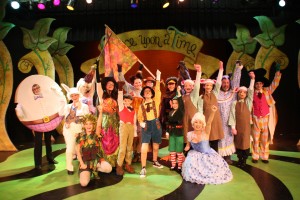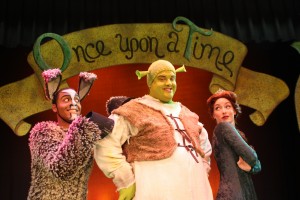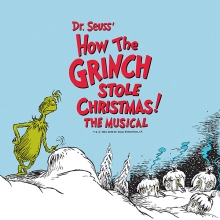Filichia Features: A Shrek Where It’s Easier Being Green
Filichia Features: A Shrek Where It’s Easier Being Green
Here’s some advice to directors who’d like to do Shrek.
Don’t dread the thought of that heavy latex headpiece that your Shrek would wear.
Do as Stephen L. Fredericks did in his production of Shrek at The Growing Stage in Netcong, New Jersey.
Fredericks didn’t put even a wisp of latex anywhere near Tommy J. Dose, whom he (wisely) entrusted to bring the ogre to life. Instead, Fredericks slathered Dose’s face and neck in green makeup, put an olive green stocking cap on his head topped by an oval band from which Shrek’s trademark ear-horns protruded. Once Fredericks gave Dose some green gloves that were large enough to pass for catchers’ mitts, he had his Shrek.
The absence of latex allowed the audience to see the many expressions that Shrek displayed during the show: his misery, his hopes, his frustration that he ever dared to trust and his ultimate joy. Seeing all these without the obfuscation of latex made for a more involving experience and did better justice to David Lindsay-Abaire’s excellent book and lyrics.
Fredericks also tried something new with Shrek’s mother and father. He didn’t cast a Mama Ogre and Papa Ogre to teach their oversized and unconventional-looking son the grim reality of life: “Every dream comes true -- but not for you.” Fredericks instead chose to have a large painted family portrait of the three ogres, with one additional detail. The characters’ mouths were open slits that could move up-and-down, down-and-up while off-stage actors sang the lyrics of the opening song.
Truth to tell, any production would profit from putting actors on stage and skipping the portrait. Such a gimmick made the lyrics hard to understand, and audiences – especially in a small theater such as Growing Stage – always rely on lip-reading more than they realize to understand sung words.
It’s not as if Fredericks didn’t have the manpower and womanpower to cast the parents. In the next scene, he displayed more than a dozen adults and kids to play the fairy tale characters who’d been displaced by evil Lord Farquaad. One fewer man and woman in the scene wouldn’t have been missed, while Shrek’s parents decidedly were.
While Fredericks kept to the Broadway template of dressing his characters as Peter Pan, Big Bad Wolf, Humpty Dumpty and all the others, no one would mind if you dusted off those fairy tale costumes from other characters that you had in previous productions. See what outfits are sitting on your racks and a-mouldering in your trunks; the more you use, the more opportunities you’ll give kids who are just dying to get on stage.
All these fairy tale refugees find that Shrek is not a gracious host. That brings us to the show’s important theme that elevates it above standard musical comedy. Shrek has been so inured to everyone’s hating him at first sight that he makes pre-emptive strikes to all he meets. His motto might well be “Act gruffly to others before they can rebuff you.” In developing this philosophy, Shrek has almost convinced himself that he doesn’t need friends and that he’s better off alone.

If someone isn’t nice to him soon, Shrek will be too far gone to ever recover and will lose the chance to become the nice “person” that he could be. Luckily for Shrek, into his life comes Donkey, a loquacious but lovable beast who’s so distinctive that he really deserves a name.
Here at Growing Stage, Brandon Lavon Hightower proved that Donkey, to mix a metaphor, is a great role for horsing around. Hightower seemed to enjoy being clad in what might best be described as a furry onesie. Any Donkey should be able to sing (and wail) the blues, and Hightower did that admirably.
Donkey does seem a little needy – especially when he tells Shrek “I need you!” about a dozen times. But that’s what’s been missing from Shrek’s life: someone who truly does need him. Such a situation has never happened before, and a long time must pass before the ogre dares to let down his guard. That’s why in “Travel Song,” while choreographer Jillian Petrie had Shrek let loose a bit and dance along with Donkey, she made the ogre’s face retain its usual sour expression.
For “What’s Up, Duloc?” – the fancifully named production number in which we’re welcomed into town – Petrie’s choreography was purposely simple, for the number is meant to be a replication of the dancing employed in old TV variety shows: time-steps with lots of arm thrusts punctuating lyrics. (Jeanine Tesori’s music is fun to sing, too.) Thus, it won’t tax even your least experienced dancers.
Shrek can’t turn around his feelings in just one dance. Like most anti-social people, he wasn’t born that way, but devolved into that behavior from being constantly mocked and bullied. Young theatergoers who see Shrek may well better understand how that surly person who lives down the street got that way. Better still, they may now offer some kindness to these dour unfortunates who have put up walls to keep from being hurt again after a lifetime of disappointments.
The ogre will encounter another challenge after he meets Princess Fiona. He’s smitten with her, but he doesn’t allow himself to dream the impossible dream – that such a beauty could possibly fall in love with him.
At Growing Stage, Emily Cara Portune shrewdly conveyed that Princess Fiona is no fairy-tale innocent. She was world-weary from the curse that said she’d be stuck in her tower until her true love rescued her. Portune showed that a lifetime of waiting resulted in her feet being planted firmly on the ground and that she had no expectations that a happy ending could be in store for her.
That’s not the only spell that Fiona must endure. While she’s beautiful by day, you know fairy tales: at night, she turns into a harridan. (No wonder so many kids are afraid of the dark.)
Donkey accidentally discovers Fiona’s secret. “Who could love such a hideous ugly beast?” she asks, as Shrek happens to be passing by. He assumes she means him, and now he’s furious at Donkey for encouraging his romance with Fiona and for being stupid enough to believe that anyone could love him.
Shrek treats Donkey terribly, but the animal is quick to excuse the ogre’s bad behavior. “That’s what friends do! They forgive each other!” These are valuable lines for everyone to hear, because they make clear that fights will occasionally occur in all friendships. The solution is not to stay angry with each other, but to solve the problem and resume the friendship as if nothing ever happened.
Better still, Shrek also teaches its audience members how to apologize. Shrek says to Donkey, “I’m sorry – okayyyy?” That’s not adequate, because the “Okayyyy?” says that Shrek is annoyed that Donkey requires an apology. “Okayyyy?” suggests that the one who’s been hurt is a finicky stickler who’s weak for needing an apology. No – the person who should be saying “Okay” is the offended party after the wrongdoer sincerely says “I’m sorry.”
Fiona, however, isn’t as quick to forgive Shrek’s insensitivity towards her, and will marry Lord Farquaad on the rebound. Fine with him, for a decree says he cannot advance to king unless he marries a princess. Here the show is beneficial in teaching kids the dangers of making hasty decisions, especially when they’re angry.
To establish that the Lord is as short as the term papers that Kate Monster gets from her kindergarteners, original director Jason Moore put Christopher Sieber in a chair on rollers, covered his legs with cloth that sported tiny little legs that hung from his doublet. Fredericks did the same here with the nicely menacing Jason Scott Quinn and got the laughs he might have expected from the funny visual image.
But how about casting Farquaad with one of your young boys who’s small in stature but tall in talent? Seeing a little peanut woo the hand of a towering princess could be just as funny -- if not funnier.
On the other end of the spectrum, Shrek at last gives the opportunity for a lad with heft to play a lead. When the musical Hairspray happened, John Waters, the writer-director of the movie on which it was based, said that he was thrilled that a heavy-set girl could finally have a starring role. Shrek offers a heavy-set boy the same opportunity.
In the film, Shrek has a Scottish accent, but it’s not a requirement for the actor who plays him. At auditions, if you find that your first choice for Shrek can maneuver the burrish sound, sure, use it and him. But if he can’t, don’t let that be the barrier to casting him. It’s more important that he be understood clearly.
What’s touching about Shrek is that Princess Fiona doesn’t shake her spell at story’s end, but remains as green as Shrek. The song now at the end of the show, “Beauty Ain’t Always Pretty,” may sound oxymoronic, but on closer expection, it’s correct – because beauty can also be measured by outlook, personality and temperament. Your one true love doesn’t have to look like a million, but he or she must be one in a million.
Last and probably least, here’s a memo to Wall Street speculators: invest in a company that manufactures green makeup. Theater companies will be buying buckets of it for decades to come. They’ll need it to coat the faces of their Shreks and – should school or community theater directors live long enough – their Elphabas.

You may e-mail Peter at pfilichia@aol.com. Check out his weekly column each Tuesday at www.masterworksbroadway.com and each Friday at www.kritzerland.com. His new book, Strippers, Showgirls, and Sharks – a Very Opinionated History of the Broadway Musicals That Did Not Win the Tony Award is now available at www.amazon.com.


























